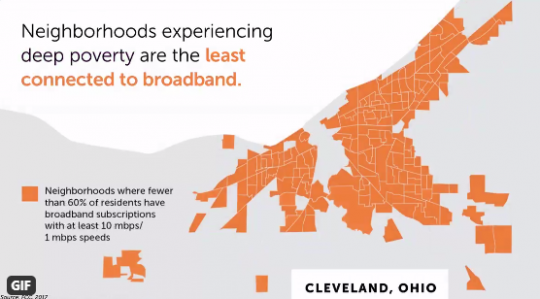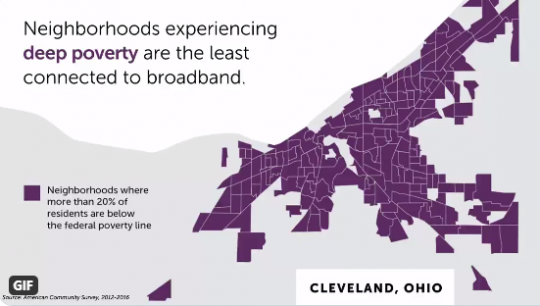Inequitable Broadband Infrastructure Limits Our Children’s Opportunities to be Healthy, Access Education, and Flourish into Adulthood
September 25, 2020
 By Alison Paxson, Communications & Policy Associate
By Alison Paxson, Communications & Policy Associate
According to census data released last week, Cleveland, Ohio is now the poorest big city in America. Interestingly, Cleveland’s pre-COVID poverty rate of 30.8% mirrors another critical figure the city is ranking poorly in – its connectivity.
In 2019, 30.7% of Cleveland households had no access to broadband internet of any type, including cellular data, and 45.96% had no wired connection, making it the worst-connected city with more than 100,000 households in the United States. In fact, in the list compiled by the National Digital Inclusion Alliance (NDIA), there were five Ohio cities with populations of 65,000 or more where more than 20% of households had no broadband access: Cleveland, Lorain, Canton, Youngstown, and Dayton.
Inequitable access to the internet has persisted for decades without being adequately addressed by state and federal leaders, and it has created sizable digital divides and even digital deserts where the lack of affordability and/or availability of internet is having far-reaching implications for children and families throughout Ohio and across the country.
Access to affordable broadband internet is now so intertwined with our health and life outcomes that experts are beginning to call it a “super-determinant of health”.
 Broadband access impacts nearly every social determinant of health – from education, to economic sustainability, health and wellness, food and housing security, and all of the conditions in our communities where we live, work, play and learn. In this digital age, broadband is absolutely essential infrastructure, and the importance of it could not be more amplified in its necessity than now during the COVID-19 pandemic.
Broadband access impacts nearly every social determinant of health – from education, to economic sustainability, health and wellness, food and housing security, and all of the conditions in our communities where we live, work, play and learn. In this digital age, broadband is absolutely essential infrastructure, and the importance of it could not be more amplified in its necessity than now during the COVID-19 pandemic.
Now that many children are learning remotely, a child’s access to the internet and necessary devices determines their access to their educations. A majority of job seekers rely on it for employment opportunities, as do the recruiters who are looking for employees to hire. For families applying for public assistance and benefits during this time, like SNAP, Medicaid, and unemployment, internet access is vital, especially in light of prohibitively long wait times over the phone. Recently expanded telehealth  options for Ohio families are a critical step in the right direction, but without internet, convenient communication with one’s physician and keeping children up to date with their pediatrician visits becomes more challenging. Not to mention the barriers posed by lack of internet for someone to access their electronic health records.
options for Ohio families are a critical step in the right direction, but without internet, convenient communication with one’s physician and keeping children up to date with their pediatrician visits becomes more challenging. Not to mention the barriers posed by lack of internet for someone to access their electronic health records.
Contrary to popular belief, broadband inequities are an urban as well as a rural issue. Indeed, ACS data indicates that the number of urban households living without access to the internet is more than triple the number of rural households in the U.S. The digital divides we see in urban areas in particular point to the huge problem of affordability, and in these challenging times, the price of an internet subscription that totals $70 per month or more is just not possible for many families to pay.
Of course, access to the internet in Ohio’s rural and Appalachian areas remains a pervasive issue as well, especially in terms of internet infrastructure and availability. When the market fails to incentivize internet providers to invest in rural communities that are geographically remote, digital deserts emerge and our inaction to regulate internet providers leaves many already isolated rural children and families unconnected and unable to access opportunities and services they need to thrive. A recent survey conducted by the Appalachian Children’s Coalition found that one in four school districts surveyed in southeastern Ohio have no internet access.
Further, in the same way we see the pandemic disproportionately impacting our Black and Brown children and their families, there is also a disparate impact in how BIPOC communities are experiencing digital poverty. The Brookings Institute reports: “While the average majority-white tract had an average broadband adoption rate of 83.7%, the average majority-Black tract (more than 50% Black residents) had a broadband adoption rate of just 67.4%.”
Bottom line: Ohio’s inequitable broadband infrastructure is creating concentrations of digital poverty – ones as small as individual houses on urban neighborhood blocks or as expansive as whole counties in rural regions – and these areas of digital inequity, where the digital divide is as blatant (and similar) as red lines on a map, are making our children poorer, less healthy, less educated, and less likely to thrive.
What will our legislature and our policymakers at all levels do to make sure that our communities are prepared for all children to have equal access to health, education, economic opportunity, higher education, and career training? We can take steps to address digital inequity in Ohio’s rural and urban regions starting with these key actions:
Make broadband internet a public utility.
Internet has become as essential to our society and being able to flourish within it as running water, heat in our homes, and other public utilities we would not think of being unregulated. The best way to address the biggest problem with our broadband infrastructure – its affordability – is by making it accessible to everyone and treating it as a public utility. A publicly-owned broadband network would boost our economy and ensure everyone had access to quality internet service at an adequate mbps (milibytes per second) upload and download speed.
Pass the Digital Equity Act of 2019.
This is a key piece of federal legislation introduced in the Senate last year that would support a diverse array of digital equity projects at the state and local level to help close the digital divide, including funds to support state planning and implementation and also money towards a competitive grant pool for training and devices. Pivotally, this piece of legislation would mean that states would begin to be funded for the sizable task and investments needed to begin to expand broadband internet. This bill is currently in the Senate Commerce, Science, and Transportation Committee. We need to urge our Senators Brown and Portman to sign on as co-sponsors and push for the passage of this bill before it dies at the end of this general assembly.
Support Ohio’s HB 13.
HB 13, currently in Ohio’s Senate Energy and Public Utilities Committee, would establish a residential broadband expansion program in Ohio. This is a needed step towards elevating accessibility. The legislation provides for $20 million to support expanded access, however the need in Ohio is in excess of $1 billion. Further, beyond connectivity, more needs to be done to address affordability.
Cultivate relationships between institutional partners at the state and local level with common interests.
We need to align partnerships for digital equity and inclusion initiatives based on their shared incentive to actually see these projects through and elevate internet access and affordability. There is a nexus of community anchors like schools and hospitals which stand to benefit from a more connected community. It makes sense for these partners to work together because there is a shared return on investment.
Improve digital literacy and address Digital Readiness Gaps.
It is important to note that social and economic outcomes are not improved simply by having the internet alone. Once one has connectivity, it is critical that they also have an understanding of how to use it and their devices in order to access remote services such as telehealth, educational opportunities, and other services and programs.
These are critical issues that will not only impact our children today – many of whom who are involved in remote learning – but their lives far into the future and beyond this pandemic.

